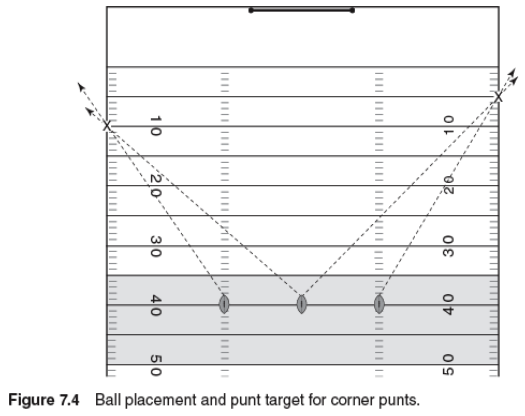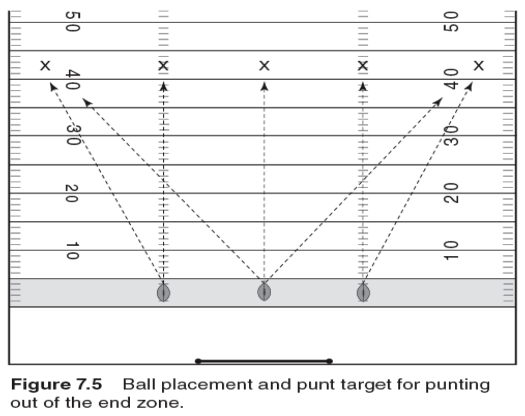Techniques vary for punting a football
This is an excerpt from Football Kicking and Punting by Ray Guy,Rick Sang.
Punting to the Corner
Situation
The football is near the 50-yard line (figure 7.4). Because the football is near midfield, an intense punt rush by the return team is less likely because of the increased probability of a fake punt by the punting team.

Objective
The punter wants to angle his punting approach toward either sideline at a point between the 10- and 5-yard line markers to place the football inside the opponent's 20-yard line at a position nearest the goal line.
The coffin corner is either corner of the playing field formed by the sideline and just in front of the end zone. A punter might try to place the ball so that it lands and goes out of bounds or is downed near the corner, thus forcing the receiving team to play very close to its goal line and maximizing the distance the receiving team must travel to score.
The coffin corner punt is a controlled drive punt normally driven at a lower trajectory out of bounds with the intent to pin the opponent deep in its own territory. The punter tends to hold the football on his approach slightly lower and longer before the drop. This natural adjustment produces more of a drive punt that's more proficient in accuracy and distance. Because the objective is to have the football land completely out of bounds and off the field of play, minimal hang time is needed (because there's no threat of a return).
Sometimes a punter attempts to punt for the corner when he's outside of his range; in this case, the ball might simply roll dead deep in the opponent's territory before going out of bounds. This might prove effective, but the coverage team must be alert in case of an attempt to return the football.
Punting to the Right Corner
When punting to the right corner, the right-footed punter needs to consider aiming at a particular point out of bounds that's closer to the goal line, preferably the 5-yard line. When punted correctly by a right-footed punter, the ball will spin clockwise and tend to fade to the right as it noses over. By aiming tighter to the goal line, the punter plays the natural fade and allows room for the punt to be effective. For example, if the punter truly aims at a point directly over the 5-yard line, as the football turns over and begins to fade, it should go out of bounds within the 10-yard line, well within the 20-yard line objective.
By aiming over the 5-yard line, the punter gives himself a 5-yard cushion to either side. This allows him to play it safe and keep the football out of the end zone, avoiding a touchback. This strategy enables him to place the football well within the 20-yard line and actually closer to the 10-yard line.
Punting to the Left Corner
When punting to the left, the right-footed punter considers aiming at a particular point out of bounds that's more away from the goal line, preferably the 10-yard line. Again this allows him to play the fade. As it noses over, the punt will fade naturally toward the right and go out of bounds, ideally near the 5-yard line mark or even closer.
A left-footed punter will need to reverse these instructions. The football will spin counterclockwise, tending to fade to the left as it noses over. This means a left-footed punter will need to aim closer to the goal line over the 5-yard line when going for the left corner and aim more toward the 10-yard line when going for the right corner.
Punting Out of the End Zone
Situation
The football is generally within the punt team's 5-yard line (figure 7.5), creating a tight punting situation in which the normal depth of the punter's alignment is minimized. The likeliness of an all-out rush increases the closer the punting team is to its own goal line. In this case, a hard rush is expected because the punter is standing deep in his team's own end zone.

Objective
Because a heavy rush is expected and the normal stepping pattern distance is decreased, the punter adjusts his approach to quickly get the punt off. Punt distance is desperately needed to regain some field position and get the punting team out of the hole. More important, hang time is crucial to minimize a return.
Obviously, punting out of the end zone tends to bring the most intense rush. Because the punt team has a limited distance to protect, the punt-return team has a greater opportunity to block the punt and a chance to speed up the punter's rhythm and force a bad punt. The punt-return team also would anticipate a mishandled snap allowing them a quick opportunity to score.
In this situation it's challenging for the punter to punt the football toward the numbers outside the hashmark in order to use the sideline to minimize the coverage area, especially because an intense rush will likely come from outside the protection and up the middle. Thus the punt team must first protect the punter and second release and cover effectively. Because of the likely rush pressure from outside, the punter should punt straight ahead to maximize protection. By maximizing hang time and distance, he provides a greater opportunity for the coverage team to protect and be more effective getting downfield to minimize the return.
Even if the return team is unable to block the punt, it can cause the punt team to do a poor job of covering downfield by forcing them to focus more on protection of the punter.
When punting out of the end zone, the punter focuses on his alignment and stance. He's deep in the back of the end zone and close to the endline. He needs to position his feet well ahead of this line and not right up against it while in his stance. If a punter inadvertently moves his foot back as he receives the snap and steps on the back line, he would be ruled out of bounds. This is a technique that the punter develops through practice. By aligning at least a foot ahead of the back line, he minimizes the risk of stepping out of bounds, especially if he uses proper technique by moving forward to meet the snap.
Another aspect of punting out of the end zone that needs to be considered regarding alignment is the distance from the line of scrimmage. If the football is inside the 5-yard line, the distance separating the punter from the oncoming rush is reduced as well. (This is commonly called a tight punt situation.) The more inside the 5-yard line the football is spotted, the less room the punter has to take his normal steps during his approach to punt the football downfield.
The best way to approach this type of punt is for the punter to shorten his steps to cover less distance. By practicing this technique and allowing it to develop naturally, the punter can still maintain a quick, rhythmic get-off time. This technique allows him to use his normal stepping approach (two or two and a half), which keeps the approach consistent with his normal stepping pattern.
An advantage of punting from a tight punt formation inside the 5-yard line is that the snapped football has less distance to travel and thus will be received by the punter quicker than usual. This faster snap assists the punter, along with his shorter and quicker steps, allowing him to offset the closer distance between the block point of the punt and the oncoming rush.
More Excerpts From Football Kicking and PuntingSHOP

Get the latest insights with regular newsletters, plus periodic product information and special insider offers.
JOIN NOW
Latest Posts
- Using double inclinometers to assess cervical flexion
- Trunk flexion manual muscle testing
- Using a goniometer to assess shoulder horizontal adduction
- Assessing shoulder flexion with manual muscle testing
- Sample mental health lesson plan of a skills-based approach
- Sample assessment worksheet for the skill of accessing valid and reliable resources


